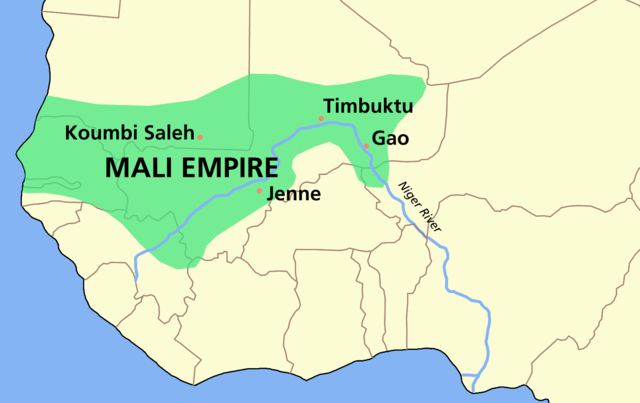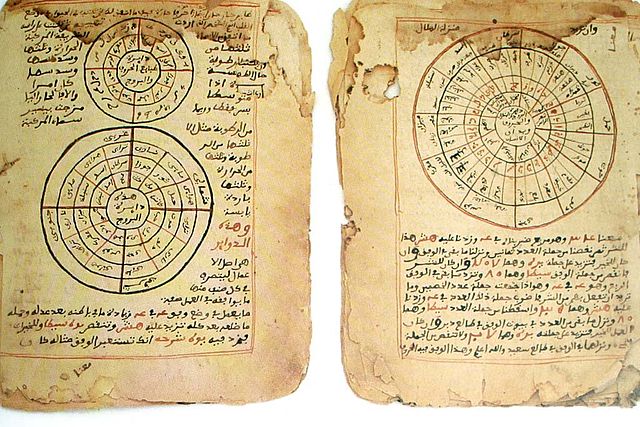11.14: Mali
- Page ID
- 72300
Learning Objective
- Evaluate each period in the history of the Mali Empire
Key Points
- The Mali Empire, also historically referred to as the Manden Kurufaba, was an empire in West Africa that lasted from c. 1230 to 1600. It was the largest empire in West Africa and profoundly influenced the culture of the region through the spread of its language, laws, and customs along lands adjacent to the Niger River, as well as other areas consisting of numerous vassal kingdoms and provinces.
- Modern oral traditions recorded that the Mandinka kingdoms of Mali or Manden had already existed several centuries before unification. This area was composed of mountains, savanna, and forest providing ideal protection and resources for the population of hunters. Those not living in the mountains formed small city-states.
- The combined forces of northern and southern Manden defeated the Sosso army at the Battle of Kirina in approximately 1235. This victory resulted in the fall of the Kaniaga kingdom and the rise of the Mali Empire.
- The Mali Empire covered a larger area for a longer period of time than any other West African state before or since. What made this possible was the decentralized nature of administration throughout the state. Its power came, above all, from trade.
- The Mali Empire reached its largest size and flourished as a trade and intellectual center under the Laye Keita mansas (1312–1389). The empire’s total area included nearly all the land between the Sahara Desert and the coastal forests.
- The 1599 battle of Djenné marked the effective end of the great Mali Empire and set the stage for a plethora of smaller West African states to emerge.
Terms
mansa
A Mandinka word meaning “sultan” (king) or “emperor.” It is particularly associated with the Keita dynasty of the Mali Empire, which dominated West Africa from the 13th century to the 15th century.
muezzin
The person appointed at a mosque to lead and recite the call to prayer for every event of prayer and worship. The muezzin’s post is an important one, and the community depends on him for an accurate prayer schedule.
Introduction
The Mali Empire,
also historically referred to as the Manden Kurufaba, was an empire in West Africa that lasted from c. 1230 to 1600. The empire was founded by Sundiata Keita and became renowned for the wealth of its rulers. It was the largest empire in West Africa and profoundly influenced the culture of the region through the spread of its language, laws, and customs along lands adjacent to the Niger River, as well as other areas consisting of numerous vassal kingdoms and provinces.
Pre-Imperial Mali
Modern oral traditions recorded that the Mandinka kingdoms of Mali or Manden had already existed several centuries before unification by Sundiata, a Malian mansa also known as Mari Djata I, as a small state just to the south of the Soninké empire of Wagadou (the Ghana Empire). This area was composed of mountains, savanna, and forest providing ideal protection and resources for the population of hunters. Those not living in the mountains formed small city-states such as Toron, Ka-Ba, and Niani.
In approximately 1140, the Sosso kingdom of Kaniaga, a former vassal of Wagadou, began conquering the lands of its old masters. By 1180, it had even subjugated Wagadou, forcing the Soninké to pay tribute. In 1203, the Sosso king Soumaoro of the Kanté clan came to power and reportedly terrorized much of Manden, stealing women and goods from both Dodougou and Kri.
After many years in exile, first at the court of Wagadou and then at Mema, Sundiata, a prince who eventually became founder of the Mali Empire, was sought out by a Niani delegation and begged to combat the Sosso and free the kingdoms of Manden. Returning with the combined armies of Mema, Wagadou, and all the rebellious Mandinka city-states, Maghan Sundiata, or Sumanguru, led a revolt against the Kaniaga Kingdom around 1234. The combined forces of northern and southern Manden defeated the Sosso army at the Battle of Kirina (then known as Krina) in approximately 1235. This victory resulted in the fall of the Kaniaga kingdom and the rise of the Mali Empire. After the victory, King Soumaoro disappeared and the Mandinka stormed the last of the Sosso cities. Maghan Sundiata was declared “faama of faamas” and received the title “mansa,” which translates roughly to emperor. At the age of eighteen, he gained authority over all the twelve kingdoms in an alliance known as the Manden Kurufaba. He was crowned under the throne name Sunidata Keita, becoming the first Mandinka emperor. And so the name Keita became a clan/family and began its reign.
Imperial Mali (1250–1559)
The Mali Empire covered a larger area for a longer period of time than any other West African state before or since. What made this possible was the decentralized nature of administration throughout the state; yet the mansa managed to keep tax money and nominal control over the area without agitating his subjects into revolt. Officials at the village, town, city, and county levels were elected locally, and only at the state or provincial level was there any palpable interference from the central authority in Niani. Provinces picked their own governors via their own custom (election, inheritance, etc.), but governors had to be approved by the mansa and were subject to his oversight.
The Mali Empire flourished because of trade above all else. It contained three immense gold mines within its borders, and the empire taxed every ounce of gold or salt that entered its borders. By the beginning of the 14th century, Mali was the source of almost half the Old World’s gold, exported from mines in Bambuk, Boure, and Galam. There was no standard currency throughout the realm, but several forms were prominent by region. The Sahelian and Saharan towns of the Mali Empire were organized as both staging posts in the long-distance caravan trade and trading centers for the various West African products (e.g., salt, copper). Ibn Battuta,
a Medieval Moroccan Muslim traveler and scholar, observed the employment of slave labor. During most of his journey, Ibn Battuta traveled with a retinue that included slaves, most of whom carried goods for trade but would also be traded themselves. On the return from Takedda to Morocco, his caravan transported 600 female slaves, which suggests that slavery was a substantial part of the commercial activity of the empire.
The number and frequency of conquests in the late 13th century and throughout the 14th century indicate that the Kolonkan mansas (who ruled at the time) inherited and/or developed a capable military. However, it went through radical changes before reaching the legendary proportions proclaimed by its subjects. Thanks to steady tax revenue and a stable government beginning in the last quarter of the 13th century, the Mali Empire was able to project its power throughout its own extensive domain and beyond. The empire maintained a semi-professional full-time army in order to defend its borders. The entire nation was mobilized, with each clan obligated to provide a quota of fighting-age men. Historians who lived during the height and decline of the Mali Empire consistently recorded its army at 100,000, with 10,000 of that number being made up of cavalry.
The Mali Empire reached its largest size under the Laye Keita mansas (1312–1389). The empire’s total area included nearly all the land between the Sahara Desert and the coastal forests. It spanned modern-day Senegal, southern Mauritania, Mali, northern Burkina Faso, western Niger, the Gambia, Guinea-Bissau, Guinea, the Ivory Coast, and northern Ghana. The first ruler from the Laye lineage was Kankan Musa Keita (or Moussa), also known as Mansa Musa. He embarked on a large building program, raising mosques and madrasas in Timbuktu and Gao. He also transformed Sankore from an informal madrasah into an Islamic university. By the end of Mansa Musa’s reign, the Sankoré University had been converted into a fully staffed university, with the largest collections of books in Africa since the Library of Alexandria. During this period, there was an advanced level of urban living in the major centers of the Mali. Sergio Domian, an Italian art and architecture scholar, wrote the following about this period: “Thus was laid the foundation of an urban civilization. At the height of its power, Mali had at least 400 cities, and the interior of the Niger Delta was very densely populated.”

Collapse
Mansa Mahmud Keita IV was the last emperor of Manden, according to the Tarikh al-Sudan. He launched an attack on the city of Djenné in 1599 with Fulani allies, hoping to take advantage of Songhai’s defeat. Eventually, the army inside Djenné intervened, forcing Mansa Mahmud Keita IV and his army to retreat to Kangaba. The battle marked the effective end of the great Mali Empire and set the stage for a plethora of smaller West African states to emerge. Around 1610, Mahmud Keita IV died. Oral tradition states that he had three sons who fought over Manden’s remains. No single Keita ever ruled Manden after Mahmud Keita IV’s death, thus the end of the Mali Empire.
The old core of the empire was divided into three spheres of influence. Kangaba, the de facto capital of Manden since the time of the last emperor, became the capital of the northern sphere. The Joma area, governed from Siguiri, controlled the central region, which encompassed Niani. Hamana (or Amana), southwest of Joma, became the southern sphere, with its capital at Kouroussa in modern Guinea. Each ruler used the title of mansa, but their authority only extended as far as their own sphere of influence. Despite this disunity in the realm, the realm remained under Mandinka control into the mid-17th century. The three states warred on each other as much if not more than they did against outsiders, but rivalries generally stopped when faced with invasion. This trend would continue into colonial times against Tukulor enemies from the west.

Sources
- Boundless World History. Authored by: Boundless. Located at: https://www.boundless.com/world-history/textbooks/boundless-world-history-textbook/. License: CC BY-SA: Attribution-ShareAlike

